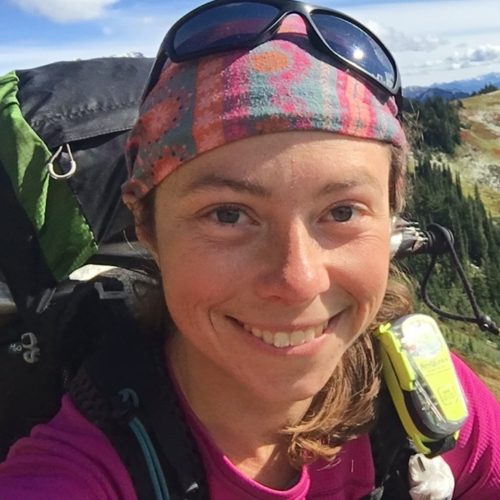CDC Investigation Finds Norovirus Risk Everywhere in PCT Cabin
Last summer, a team from the Centers for Disease Control and Prevention (CDC) set out on the PCT in Washington to investigate reports of numerous sick hikers in the area. The team hiked out to a popular rest stop along the trail: a log cabin with a pit toilet and a nearby stream that’s used for drinking water. During their examination of the area, the team swabbed every surface inside the cabin and latrine, hoping to discover what was making the hikers sick.
The result? Every single surface was contaminated with microscopic bits of poop, and all that poop was a perfect haven for norovirus.
What is Norovirus?
Norovirus is a group of viruses that causes inflammation of the stomach and intestines. It takes only a few particles of the virus to make someone sick, and an infected person sheds billions of particles through their vomit and feces.
In the PCT cabin, the CDC determined that infected hikers had contaminated their hands or clothes — likely while using the latrine — and spread norovirus particles onto every object at the rest stop.
It doesn’t help that norovirus has superpowers against hand sanitizer and water filters. It can survive temperatures as high as 140 degrees Fahrenheit and remain active on surfaces for days or even weeks. It’s extremely contagious and I can tell you personally that it’s a nightmare to experience.

Image credit: National Park Service
Symptoms
I caught norovirus in staff housing a couple of years ago, and for two days, I was basically a double-ended firehose.
What started as mysterious appetite loss during the day transformed into “spewmaggedon” by evening: vomiting so violently that my entire ribcage felt bruised and so much lava coming out the other end that I was afraid to leave the bathroom.
With norovirus, vomiting and diarrhea happen so frequently that dehydration becomes a major concern, and I was no exception. Despite the twelve-pack of Gatorade provided by a courageous coworker, I was so dehydrated that it was difficult to think straight, and it took everything I had to make it the five whole steps into the bathroom. My body finally ran out of things to spew by the next morning, and I didn’t fully recover for several days after that.
That was in a house with a toilet. I cannot imagine what it would be like to have norovirus in the middle of a hike.

Would I have had time to dig a cathole? Somehow, I doubt it. Photo credit: Kelly Floro
CDC Findings
“Norovirus prevention in remote areas is difficult because of a lack of easily available clean water and soap for handwashing, and inability to routinely disinfect shared surfaces (e.g., cabins and restrooms),” says the CDC’s 2022 report. “Moreover, alcohol-based hand sanitizers, commonly used in hiking, are not effective against norovirus.”
Surface transmission, as demonstrated by the tests conducted at the PCT cabin, is a major cause of illness in hikers. Touching contaminated surfaces and then touching your mouth, sharing eating utensils, reaching hands into each other’s food bags — all of these are easy ways to share virus particles.

Look at the dirt. THE DIRT. Would you want me putting those hands in your trail mix? Of course not. Ew.
Unfortunately, surface transmission isn’t the only way to transmit norovirus. The CDC also tested the cabin’s nearby water source. In this case, the water was clean, but it’s all too easy for water sources to become contaminated if hikers poop or vomit close by. Not only is norovirus strong enough to withstand hand sanitizer, but the particles are also small enough to slip right through water filters.
Avoiding Norovirus
In an article for NPR, Shanna Miko, a nurse epidemiologist for the CDC, offered some general advice to hikers for protecting themselves against the virus.
First and foremost, use soap and water to wash your hands whenever possible. Hand sanitizer doesn’t remove dirt and debris from your hands the way scrubbing with soap does. Miko also suggested boiling your drinking water as the best way to remove contaminants. Otherwise, using backup treatment after filtering, such as UV or chemical treatment, is a good way to kill the virus.
For a more in-depth look at protecting yourself from norovirus on the trail, check out Avoiding “Spewmageddon”: How to Evade Norovirus on the AT.
Featured image courtesy of Sprinkles.
This website contains affiliate links, which means The Trek may receive a percentage of any product or service you purchase using the links in the articles or advertisements. The buyer pays the same price as they would otherwise, and your purchase helps to support The Trek's ongoing goal to serve you quality backpacking advice and information. Thanks for your support!
To learn more, please visit the About This Site page.

 ">
">


Comments 5
How enlightening and frightening.
Pack extra TP.
Curious where this cabin is located. I was around a lot of sick people in 2022 on trail though fortunately avoided it myself.
Odd you didn’t mention the location in WA. Why didn’t you?
“Washington […] popular rest stop along the trail: a log cabin with a pit toilet and a nearby stream that’s used for drinking water” — My money’s on Ulrich Cabin.
Precisely why my wife would rather take her call of nature in nature than a public restroom!